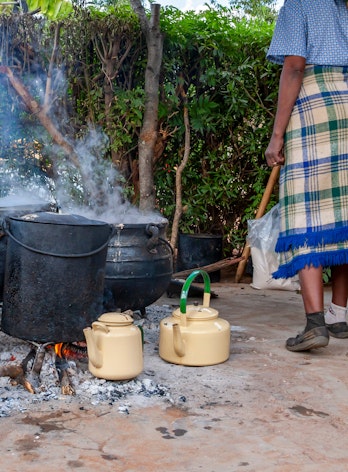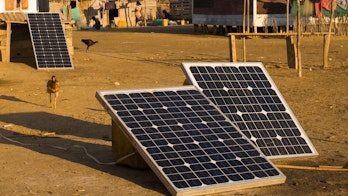
Access and Affordability
Accelerating progress towards electricity and clean cooking for all
In 2022, there were 760 million people in the world living without electricity access, while 2.3 billion people continued to rely on harmful and polluting cooking fuels such as charcoal, wood, agricultural waste and animal dung – the use of which is a leading cause of premature death and serious health issues in many of the poorest regions of the world.
The IEA is at the forefront of efforts to track and address global gaps in energy access. For more than two decades, the Agency has collected and published data on this subject – with a focus not only on making energy universally available, but also ensuring it is affordable. Together with its partners, the IEA is helping to build financial and policy momentum towards United Nations Sustainable Development Goal 7, which aims to “ensure access to affordable, reliable and modern energy for all by 2030.”
Key findings
Despite major progress, more work is needed to deliver universal electricity access by 2030
Number of people without access to clean cooking by scenario, 2022-2030
Open$8 billion in annual investment could deliver universal access to clean cooking this decade
However, universal access to clean cooking could be achieved with investment of $8 billion annually in stoves and infrastructure between now and 2030. This is less than 1% of what governments spent in 2022 globally on measures to keep energy affordable for their citizens.
Annual investments required in the Access for All scenario, by region, 2030
OpenSpeeding up clean energy transitions can make energy more accessible and affordable
Speeding up the move to clean energy technologies can improve the affordability of energy and relieve pressures on the cost of living more broadly. IEA data shows that putting the world on track for net zero emissions requires additional investment – but also reduces the operating costs of the global energy system by more than half over the next decade compared with a trajectory that is based on today’s policy settings. This results in a more affordable energy system for consumers.
Energy delivery costs by scenario, 2023 and 2035
OpenSummit on Clean Cooking in Africa
Towards a turning point on clean cooking

More than 1 billion people who currently lack access to clean cooking are in Sub-Saharan Africa. Co-chaired by the leaders of the governments of Tanzania and Norway, and the African Development Bank and the IEA, the Summit on Clean Cooking in Africa aimed to address this major inequity and make 2024 a turning point on this crucial issue.
The Summit – which drew delegates from close to 60 countries, as well as companies and development institutions – set out concrete ways in which these groups can work together to solve the clean cooking challenge this decade. What’s more, it mobilised $2.2 billion in financial pledges from governments and the private sector, a record sum dedicated to clean cooking access at a single gathering.
The IEA is committed to ensuring that momentum is now maintained. We will carefully track pledges and commitments to make sure the money is spent in a timely manner and reaches those in need. And we will continue to play a convening role to engage more willing partners and generate new funds in order to meet the $4 billion a year in capital investments required between now and 2030 to achieve universal clean cooking access in Africa.
This Summit has delivered an emphatic commitment to an issue that has been ignored by too many people, for too long. We still have a long way to go, but the outcome of this Summit, $2.2 billion committed, can help support fundamental rights such as health, gender equality and education while also reducing emissions and restoring forests.
Key analysis
Programmes and partnerships
Promoting sustainable and inclusive economic growth through energy data management and long-term planning in Sub-Saharan Africa.
Promoting sustainable and inclusive economic growth through energy data management and long-term planning in Sub-Saharan Africa.
“An Affordable and Sustainable Energy System for Sub-Saharan Africa” (Energy Sub-Saharan Africa) is a five-year programme (2019-2024) funded by the European Union. It supports work with Benin, the Democratic Republic of the Congo, Ethiopia, Ghana, Kenya, Nigeria, Rwanda, Senegal, Uganda and Zambia, with the aim of promoting sustainable and inclusive economic growth through the transition towards a low-carbon and climate-resilient energy sector, while delivering universal and affordable energy access to all.
Supporting African governments as they develop improved programmes and policies to accelerate electricity access.
Supporting African governments as they develop improved programmes and policies to accelerate electricity access.
The project by the IEA and Power Africa draws on the IEA’s expertise to support governments with data-driven insights as they work to expand electricity access.
Enhancing geospatial analysis to show pathways to universal electricity access.
Enhancing geospatial analysis to show pathways to universal electricity access.
This open-source GIS tool, developed in collaboration with the MIT Energy Initiative, was designed to estimate and forecast electricity demand at the building-level in developing economies. The tool leverages a machine learning model trained on geo-referenced data of electricity consumption sourced from utility meters in three pilot countries – Ghana, Senegal and Uganda. It can then predict electricity demand for buildings that lack meter data or have yet to be electrified with high resolution and high accuracy. The tool can be applied to satellite images of entire countries, and produce significantly improved estimates for planners, utilities, and off-grid solar companies to identify target customers and communities.




Access to electricity improves slightly in 2023, but still far from the pace needed to meet SDG7
Commentary — 15 September 2023